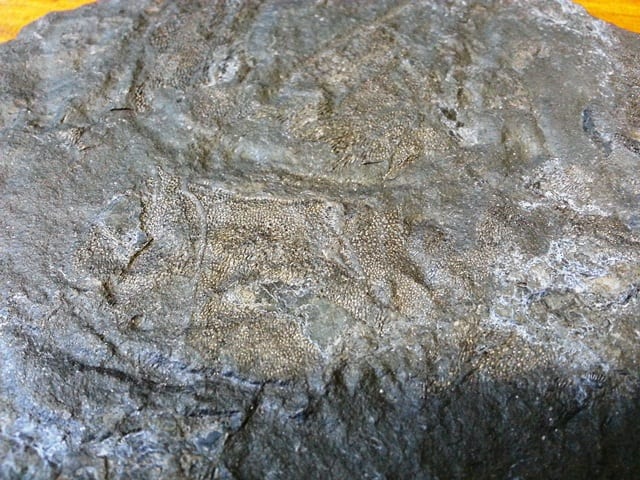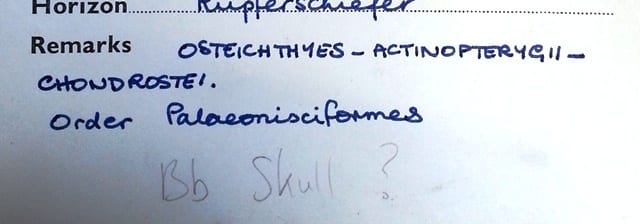Underwhelming Fossil Fish of the Month: September 2015
By Mark Carnall, on 30 September 2015
I’M BACK! Last month’s rumours of the end were nought but a dramatic device! I may have left UCL and although it was easy to turn my back and walk away from colleagues I’d worked with over the last decade, I couldn’t leave the underwhelming fossil fish behind so this communiqué comes from the Oxford University Museum of Natural History.
For first time readers, the mission of this blog series is to turn our attentions to the spectacularly unspectacular fossil fish in the Grant Museum each month. These fish, like so many others in museum collections, are uncelebratable, unrelatable and originally collected for research no longer referenced or cared about. Every museum has specimens like these. Are they useless? Why do we have them? Why should you care? None of these questions will be answered here, instead I ask that you clear your mind, read on, and one by one we’ll improve global fishteracy, one underwhelming fish fossil at a time.
This month, in order to celebrate the return of the series I’ve been sent images and a description of personally hand-picked out something particularly unspecial in time honoured tradition for this series. Extra points for you if you stay awake/alive til the end of this one, it’s a slog.

NON1252 Acrolepis. No, it isn’t a trick, that’s all there is to it. Note that this month I didn’t do the photography so apologies for the wood in the background and lack of scale bar. I know I’m going to get a flood of letters about it, dropping standards of quality etc. etc.
Ta da! I told you it was a corker. This specimen resembles a particularly uncommitted job at those textured dashboard plastic panels you find in cars. According to the ever reliable label information, this is a specimen of Acrolepis, collected from the Kupferschiefer, a layer of rock that is found across a large chunk of Northern Europe, from the east of the UK through to Poland and Lithuania. The Kupferschiefer is only metres thick and is roughly 260-250 million years old.
Don’t worry dear reader, if like me, you’re struggling to work out exactly what it is we have here. This specimen has defied generations of inspection, the old label for this specimen has ‘Skull?’ written on it. From a handful of more, how shall we say, better preserved specimens, Acrolepis was a large predatory fish, growing up to three metres in length that would have been one of the top predators of Late Permian seas and has been found in association with smaller fish including what has been interpreted as fragments as stomach contents in Acrolepis.
Preservation What is there to say in this section? Yes, technically something is preserved but what is not clear. There’s a bit of ribbing which could be muscle impressions? There’s some straight bits and some rounded bits but I’m honestly at a loss to interpret them. Sadly, there isn’t even enough here for a timely not very helpful artist’s reconstruction.
Research Interestingly, if you class quirks about historical research into fish fossils as interesting, Acrolepis is a bit of an enigma when it comes to research. Acrolepis have very distinctive scales, this website has good images of them, which our fossil doesn’t really show. So distinctive are Acrolepis scales that two papers, by the same authors, refer to ‘Acrolepis’ type scales to indicate the presence of a related but unidentifiable species (Dalquest and Kocurko 1986, 1988). Aside from that, it’s your classic underwhelming fossil fish in that Acrolepis may be referenced, in passing, amongst descriptions of more interesting animals. Poor Acrolepis, always the friend or the bridesmaid, never even the bridesmaid.

An alternative view of NON1252, this time with mood lighting. Equally uninformative as the other image though.
In Society You’ll be unsurprised to learn that Acrolepis has had so little impact on broader society, that I’ll use the space here for a NEW FEATURE called Behind The Fossil Fish feature, giving you an insight into the world of writing underwhelming fossil fish of the month. Don’t get too excited though, unlike those little ‘making of’ shorts after BBC wildlife documentaries, this is far from following a bored cameraman waiting two months for a leopard to show up. It’s more about the trials of finding information about obscure fossil fish on a Wednesday afternoon after your former manager reminds you it’s nearing the end of the month and the restless crowds are outside the Grant Museum baying for another underwhelming fossil fish blog. Behind the Fossil Fish. When I come to research these fossil fish, there are certain early warning signs as to whether there’s going to be a lot or not a lot to process to find a scrap of information here or there about the fish du jour. One indicator is how quickly on a basic Google search results, pages start degenerating into all those awful ‘dictionary list’ pages (you know the ones) and another handy one is the quality of the Wikipedia entry. Unfortunately for Acrolepis, and me, there are a number of more interesting but still slightly underwhelming living fish which have the species name acrolepis, in this case the Pacific grenadier Coryphaenoides acrolepis dominates the Internet search results. As for the Wikipedia page for Acrolepis, there’s scant information, some of which you’ll errr ‘recognise’ from here, as well as a reference to ‘the fossil specimen discovered in Germany’ with no more information than that about the specimen. Another choice sentence goes ‘The current specimen of Acrolepis is in possession of Tyne & Wear Archives and Museums’ backed up by a reference to a dead web page. You know you’re in trouble when even the Wikipedians can’t be bothered to maintain their usual high standards.
Acrolepis sp.
Preservation 0.5
Research 4
In Society -1
Underwhelmingness 8
References
Dalquest, W.W. and Kocurko, M.J. 1986. Geology and Vertebrate Paleontology of a Lower Permian Delta Margin in Baylor County, Texas. The Southwestern Naturalist
Vol. 31, No. 4 (Nov. 10, 1986) , pp. 477-492
Dalquest, W.W. and Kocurko, M.J. 1988. Notes on Permian Fishes from Lake Kemp, Baylor County, Texas, with a Synopsis of Texas Palaeonisciform Fishes. The Southwestern Naturalist. Vol. 33, No. 3 (Sep. 15, 1988) , pp. 263-274
Mark Carnall is the Collections Manager (Life Collections) at the Oxford University Museum of Natural History, and former Curator of the Grant Museum
4 Responses to “Underwhelming Fossil Fish of the Month: September 2015”
- 1
-
2
Dominic wrote on 30 September 2015:
Nice – & now we know tooth enamal evolved from fish scales!
http://www.nature.com/nature/journal/vaop/ncurrent/full/nature15259.html -
3
Georgette wrote on 22 October 2015:
Extremely relieved the underwhelming fossil fish of the month is still going. Was panicking.
-
4
Helen Doyle wrote on 7 December 2015:
Thank heavens UFFotM is still going – not only that but I have three posts to catch up on! There is no longer a fossil-fish- shaped hole in my life.
 Close
Close



Fantastic so see the fossil fish are back! It has been a grueling month, knowing (or so I thought) there wouldn’t be any underwhelming fossil at the end of it.
Happy to know it was all a cruel and mean trick played on us unsuspecting readers.